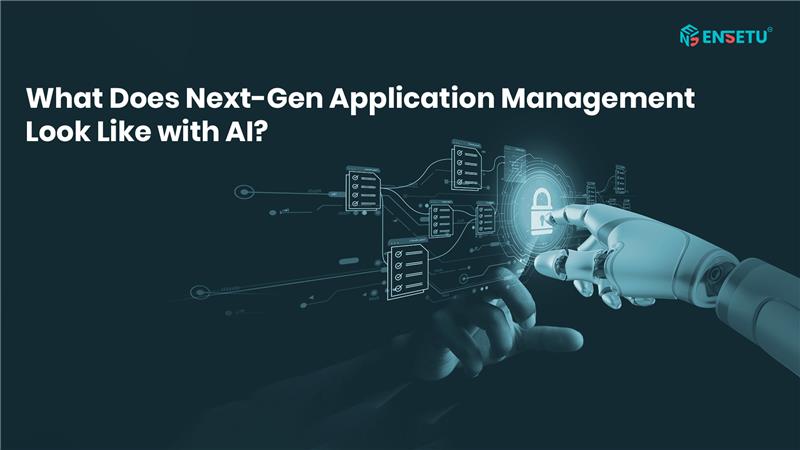
In today’s era of cloud computing, hybrid environments, and growing digital complexity, Application Management Services (AMS) are undergoing a pivotal shift. With the integration of AI, Machine Learning, and AIOps, organizations are redefining how they monitor, maintain, and optimize applications. This evolution affects not just technology but also business agility, cost-efficiency, user experience, and innovation. Let’s explore the key drivers and fresh advancements shaping the future of AMS.
The Role of AI and Machine Learning in AMS
AI and ML are at the heart of modern AMS strategies. Here’s how they are enabling transformation:
1. Predictive Incident Management & Self-Healing
AI/ML models, trained on historical logs, can detect anomalies such as traffic spikes or response delays and initiate self-healing actions. For instance, platforms like TCS’s ignio™ can automatically reroute traffic or reboot services—resolving issues before they affect users. This is crucial in industries like telecom, where even a few seconds of downtime can impact millions. One major telecom provider successfully deployed ignio™ to proactively monitor network congestion during high-demand events like sports finals, preventing potential outages.
2. Intelligent Root-Cause Analysis (RCA)
Platforms like Dynatrace and Moogsoft use ML to correlate logs, performance data, and user interactions. This accelerates RCA, reducing the mean time to resolution (MTTR) from hours to minutes. Wipro’s SPRINT framework, for instance, was deployed in a multinational manufacturing firm to support SAP landscapes. It helped cut MTTR by 50%, improving operational continuity and service levels during critical month-end closing periods.
3. Virtual Agents & Hyper-Automation
AI-driven chatbots like ServiceNow Virtual Agent automate repetitive tasks such as password resets or ticket logging. In a large healthcare setup, AI bots were trained to handle compliance-related alerts. These bots not only responded to 60% of L1 tickets but also reduced support staff workload by 45%, freeing human resources for critical support functions.
4. Business-Aligned Metrics & Intelligence
AI connects application health to business KPIs—such as cart abandonment or transaction failures. A leading e-commerce player used SAP’s AI.ERPOps to flag slow invoice processing times that were affecting customer refunds. With faster detection and action, the company reduced its order-to-cash cycles by 30%, directly improving cash flow.
Benefits of AI-Powered AMS (With Real-World Impact)
The adoption of AI/ML in AMS is not just theoretical—it’s yielding tangible benefits:
- Enhanced Reliability and Speed: AI-managed systems proactively detect and remediate issues. TCS’s ignio™ achieved 95% predictive accuracy in financial closures, helping global banks meet regulatory deadlines without delay (source).
- Operational Efficiency & Cost Reduction: Wipro’s NextGen AMS (powered by SPRINT) has delivered 35–40% TCO reduction, 75% fewer noise alerts, and 85% ticket resolution via self-healing (source).
- Stronger Security Posture: AI-enhanced systems like SAP’s AI.ERPOps identify unusual user behaviors and suspicious transactions, improving compliance for regulated sectors like banking (SAP
Source). - Strategic Decision-Making: AI dashboards link IT metrics with KPIs like order fulfillment. A logistics firm using Moogsoft AIOps improved on-time deliveries by 18% by correlating app performance with route optimization data (source).
Challenges and Considerations
Despite the gains, AI-driven AMS introduces new complexities:
- Data Privacy & Ethics: ML
models trained on logs and user data raise privacy risks. Adopting GDPR-compliant AIOps platforms like Splunk or DataDog is critical. Siemens implemented a governance framework that includes role-based access to telemetry data and audit trails for all AI-driven decisions. - Training & Change Management:
- As operations become AI-driven, teams must upskill. TCS and Cognizant run internal AMS academies to prepare engineers for automation-led roles, helping reduce resistance to change and fast-tracking implementation.
- Cost & Complexity: Initial investment in AIOps tools and cloud integration can be high. However, organizations often see ROI in under 12–18 months. A Fortune 500 company using Digitate’s AI.ERPOps reported break-even within a year after reducing high-priority incidents by 40%.
- Architecture Readiness: ML models
need high-quality, connected data. Fragmented systems slow down AI maturity. A telecom provider facing over 500 disparate logging systems adopted Elastic Observability to unify logs and metrics across services, paving the way for a successful AIOps rollout.
Building a Digital Roadmap: Practical Steps
- Assess Readiness: Use Observability Maturity Assessment to identify gaps.
- Start with Pilot Use Cases: Target areas with repetitive issues, like batch failures or access management.
- Prioritize Data Alignment: Build connected telemetry pipelines before AI implementation.
- Upskill Teams: Invest in AIOps and cloud certifications. TCS offers internal upskilling paths aligned with ignio™.
- Measure & Optimize: Leverage embedded analytics to track incident reduction, user satisfaction, and business impact.
Conclusion: Redefining AMS with AI and Machine Learning
The integration of AI and ML has elevated
AMS from a backend support function to a strategic differentiator. With
real-world implementations like TCS, Wipro, and Digitate, it’s clear that
intelligent AMS delivers measurable impact—cost savings, speed, accuracy, and
business alignment.
Organizations that prioritize ethical AI
adoption, strong data practices, and proactive upskilling will lead the way.
AMS is no longer just about managing applications—it’s about orchestrating a
smarter, more agile digital enterprise.